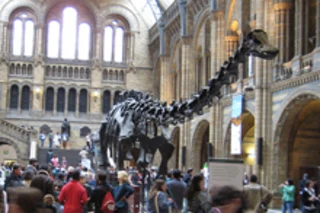The lumbering, long-necked dinosaurs known as sauropods are a staple of natural history museums and gift shops, but a new debate has broken out that challenges the poses of the museums' life-sized replicas and the toy shops' plastic figurines. The mighty sauropods Brachiosaurus and Diplodocus are commonly positioned with their long necks stretched before them, but a controversial new study argues that they actually stretched their necks up to the treetops. If sauropods did indeed hold their heads aloft like giraffes, some would have stood almost 50 feet tall. For the new study, published in the journal Acta Palaeontologica Polonica, paleontologist Mike Taylor and his colleagues took the straight-forward approach of studying the x-rays of 10 different groups of vertebrate animals. Says Taylor:
"Unless sauropods carried their heads and necks differently from every living vertebrate, we have to assume the base of their neck was curved strongly upwards. In some ...














